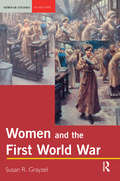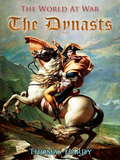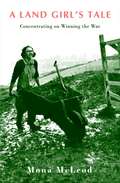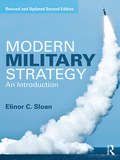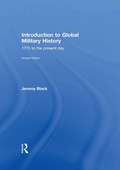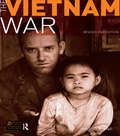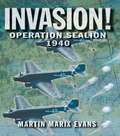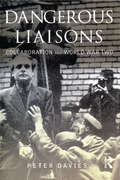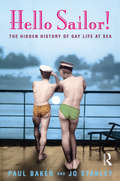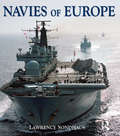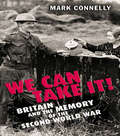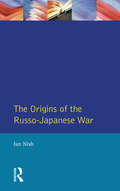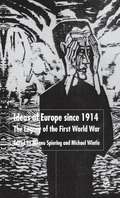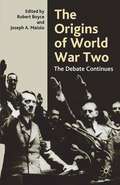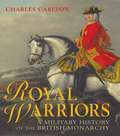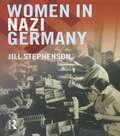- Table View
- List View
Women And The First World War
by Susan R. GrayzelWomen and the First World War provides an introduction to the experiences and contributions of women during this important turning point in history. In addition to exploring women's relationship to the war in each of the main protagonist states, the book also looks at the wide-ranging effects of the war on women in Africa, Asia, Australia, New Zealand and North America. Topical in its approach, the book highlights: The heated public debates about women's social. cultural and political roles that the war inspired Thier varied experiences of war Women's representation in propaganda Their roles in peace movements and revolutionary activity that grew out of the war The consequences of the war for women in its immediate aftermath
The Dynasts
by Thomas Hardy"The Dynasts" is an English-language drama in verse by Thomas Hardy. Hardy himself described this work as "an epic-drama of the war with Napoleon, in three parts, nineteen acts and one hundred and thirty scenes". Not counting the Forescene and the Afterscene, the exact total number of scenes is 131. The three parts were published in 1904, 1906 and 1908. Because of the ambition and scale of the work, Hardy acknowledged that The Dynasts was not a work that could be conventionally staged in the theatre, and described the work as "the longest English drama in existence". Scholars have noted that Hardy remembered war stories of the veterans of the Napoleonic wars in his youth, and used them as partial inspiration for writing The Dynasts many years later in his own old age. In addition, Hardy was a distant relative of Captain Thomas Hardy, who had served with Admiral Horatio Nelson at Trafalgar. Hardy consulted a number of histories and also visited Waterloo, Belgium, as part of his research. George Orwell wrote that Hardy had "set free his genius" by writing this drama and thought its main appeal was "in the grandiose and rather evil vision of armies marching and counter-marching through the mists, and men dying by hundreds of thousands in the Russian snows, and all for absolutely nothing."
A Land Girl's Tale (PDF)
by Mona Mcleod"I can see the disgust on the face of one neighbor when Jack, the farmer, asked to lend a man, produced a land girl." Mona Macleod worked in Kirkubrightshire during the second World War, providing the skilled labour needed on farms before mechanization. The girls were given heavy agricultural work in fields, with animals, carrying hundred weight sacks, sawing wood, felling trees, filling up rat holes. It was a tough way to grow up, but this illustrated memoir provides a record of a time when women faced the rigorous physical challenges involved in winning the war at home.
Modern Military Strategy: An Introduction
by Elinor C. SloanThis textbook provides a comprehensive introduction to post-Cold War military theory for students of strategic studies. This second edition has been fully revised and updated, including a new chapter on peacekeeping, and examines contemporary strategic thought on the conduct of war in the sea, land, air, nuclear, space and cyber domains, as well as irregular warfare. Each chapter identifies contemporary strategic thinkers in a particular area, examines strategic thought through the lens of identifiable themes, and discusses the ideas of classical strategists to provide historical context. Examples of the link between the use of military force and the pursuit of political objectives are presented, such as airpower against ISIS and in Libya, counterinsurgency in Afghanistan and Iraq, counter-piracy operations off the coast of Africa, and the Stuxnet virus in Iran. The chapters identify trends, statements and principles that indicate how military power can best be employed to effect political ends, while the conclusion paints an overall picture of the relationship between classic and contemporary strategic thinking within each warfare domain. This book will be essential reading for students of strategic studies, war studies and military history, and is highly recommended for students of security studies and international relations in general.
Modern Military Strategy: An Introduction
by Elinor C. SloanThis textbook provides a comprehensive introduction to post-Cold War military theory for students of strategic studies. This second edition has been fully revised and updated, including a new chapter on peacekeeping, and examines contemporary strategic thought on the conduct of war in the sea, land, air, nuclear, space and cyber domains, as well as irregular warfare. Each chapter identifies contemporary strategic thinkers in a particular area, examines strategic thought through the lens of identifiable themes, and discusses the ideas of classical strategists to provide historical context. Examples of the link between the use of military force and the pursuit of political objectives are presented, such as airpower against ISIS and in Libya, counterinsurgency in Afghanistan and Iraq, counter-piracy operations off the coast of Africa, and the Stuxnet virus in Iran. The chapters identify trends, statements and principles that indicate how military power can best be employed to effect political ends, while the conclusion paints an overall picture of the relationship between classic and contemporary strategic thinking within each warfare domain. This book will be essential reading for students of strategic studies, war studies and military history, and is highly recommended for students of security studies and international relations in general.
Introduction to Global Military History: 1775 to the Present Day
by Jeremy BlackThis lucid account of military developments around the modern world begins with the American War of Independence and the French revolutionary wars and continues chronologically to the latest 21st century conflicts. It combines determinedly global coverage with thought-provoking analysis not only of the military aspects of conflict but also its social, cultural, political and economic dimensions and consequences. By placing familiar events alongside the largely unknown, the reader is forced to reassess the standard grand narrative of military history that rests on assumptions of Western cultural and technological superiority. It will be essential reading for students worldwide, whether studying modern military history, modern world history, history and international relations or war and society. This fully updated second edition includes: chapter introductions and conclusions to assist study and revision 'Voices of War' sourced extracts from the field of conflict case studies in each chapter to support the narrative and provoke discussion a 12-page colour map section and over 20 other integrated maps annotated references from the latest publications in the field
Introduction to Global Military History: 1775 to the Present Day
by Jeremy BlackThis lucid account of military developments around the modern world begins with the American War of Independence and the French revolutionary wars and continues chronologically to the latest 21st century conflicts. It combines determinedly global coverage with thought-provoking analysis not only of the military aspects of conflict but also its social, cultural, political and economic dimensions and consequences. By placing familiar events alongside the largely unknown, the reader is forced to reassess the standard grand narrative of military history that rests on assumptions of Western cultural and technological superiority. It will be essential reading for students worldwide, whether studying modern military history, modern world history, history and international relations or war and society. This fully updated second edition includes: chapter introductions and conclusions to assist study and revision 'Voices of War' sourced extracts from the field of conflict case studies in each chapter to support the narrative and provoke discussion a 12-page colour map section and over 20 other integrated maps annotated references from the latest publications in the field
The Vietnam War: Revised 2nd Edition
by Mitchell K. HallThe Vietnam War examines the conflict from its origins through to 1975 and North Vietnam’s victory. This new revised edition is completely up-to-date with current academic debates and includes new source material. Mitchell Hall explores all the key elements of the conflict, including: · US motivations for entering the war and the military strategies employed · The role of the media · The rise of domestic opposition · The war’s impact in the US and Vietnam. Mitchell Hall provides numerous insights into the political decisions of the Vietnamese communists, and Vietnam’s relations with other major powers, particularly China and the Soviet Union. The main text is supported by a comprehensive documents section, and a range of study tools, including a Chronology of events, Who's Who, a Glossary of terms and a Further Reading section. Concise yet thorough, the book provides students with an accessible and stimulating introduction to the war.
The Vietnam War: Revised 2nd Edition
by Mitchell K. HallThe Vietnam War examines the conflict from its origins through to 1975 and North Vietnam’s victory. This new revised edition is completely up-to-date with current academic debates and includes new source material. Mitchell Hall explores all the key elements of the conflict, including: · US motivations for entering the war and the military strategies employed · The role of the media · The rise of domestic opposition · The war’s impact in the US and Vietnam. Mitchell Hall provides numerous insights into the political decisions of the Vietnamese communists, and Vietnam’s relations with other major powers, particularly China and the Soviet Union. The main text is supported by a comprehensive documents section, and a range of study tools, including a Chronology of events, Who's Who, a Glossary of terms and a Further Reading section. Concise yet thorough, the book provides students with an accessible and stimulating introduction to the war.
Invasion!: Operation Sea Lion, 1940
by Martin Marix Evans Angus McgeochThis terrifying alternative reality is actually based on historical facts. The book follows the real course of events up to1 September, including the planning in Britain and Germany, and the aerial war. The fictional story then supposes that the Germans halted their advance in France along the Seine and the Aisne after the fall of Paris and that Marshal Petain conceded an armistice at that point. The Panzer divisions are thus able to rest and re-equip in northern France…A brilliant blend of meticulous research and imagination, this book is bound to appeal to anyone with an interest in the causes and effects of historical events, and indeed to anyone interested in world war history itself.
Invasion!: Operation Sea Lion, 1940
by Martin Marix Evans Angus McgeochThis terrifying alternative reality is actually based on historical facts. The book follows the real course of events up to1 September, including the planning in Britain and Germany, and the aerial war. The fictional story then supposes that the Germans halted their advance in France along the Seine and the Aisne after the fall of Paris and that Marshal Petain conceded an armistice at that point. The Panzer divisions are thus able to rest and re-equip in northern France…A brilliant blend of meticulous research and imagination, this book is bound to appeal to anyone with an interest in the causes and effects of historical events, and indeed to anyone interested in world war history itself.
Dangerous Liaisons: Collaboration and World War Two
by Peter DaviesThe Nazi regime in Germany was terrible enough without even accounting for the policy of collaboration. So what extra does collaboration say about Hitler and his plans for Europe? Peter Davies explores the mindset and political attitudes of Hitler and also many other controversial pro-Nazi leaders in Western Europe, Scandanavia, Central and Eastern Europe, and also beyond. Delving into four different "types" of collaboration: political, financial, the Holocaust, and collaboration at a social level, he asks some difficult questions. The story of collaboration is brought up to date, assessing both the legacy and its contemporary parallels.
Dangerous Liaisons: Collaboration and World War Two
by Peter DaviesThe Nazi regime in Germany was terrible enough without even accounting for the policy of collaboration. So what extra does collaboration say about Hitler and his plans for Europe? Peter Davies explores the mindset and political attitudes of Hitler and also many other controversial pro-Nazi leaders in Western Europe, Scandanavia, Central and Eastern Europe, and also beyond. Delving into four different "types" of collaboration: political, financial, the Holocaust, and collaboration at a social level, he asks some difficult questions. The story of collaboration is brought up to date, assessing both the legacy and its contemporary parallels.
Hello Sailor!: The hidden history of gay life at sea
by Paul Baker Jo StanleyWhen gays had to be closeted, ships were the only places where homosexual men could not only be out but also camp. And on some liners to the sun and the New World, queens and butches had a ball. They sashayed and minced their way across the world's oceans. Never before has the story been told of the masses. These are the thousands of queer seafarers, mainly stewards, who sometimes even outnumbered the straight men in the catering departments of ships that were household names and the pride of the British fleet. Hello Sailor! uniquely shows what it was like to be queer at sea at a time when land meant straightness.
Navies of Europe
by Lawrence SondhausEurope ruled the waves for most of the modern era and even when its navies were eclipsed in size by the US force, they continued to dominate world wars. In this unique history of Europe's naval forces, Larry Sondhaus charts the development of naval warfare from the transition to steam to recent actions in the Persian Gulf. Combining detailed technical information with an in-depth comparison of warfare and tactics across some of the key conflicts of the modern world, this is an absorbing account of European and British seapower, past and present.
Navies of Europe
by Lawrence SondhausEurope ruled the waves for most of the modern era and even when its navies were eclipsed in size by the US force, they continued to dominate world wars. In this unique history of Europe's naval forces, Larry Sondhaus charts the development of naval warfare from the transition to steam to recent actions in the Persian Gulf. Combining detailed technical information with an in-depth comparison of warfare and tactics across some of the key conflicts of the modern world, this is an absorbing account of European and British seapower, past and present.
We Can Take It!
by Mark Connelly`We Can Take It!' shows that the British remember the war in a peculiar way, thanks to a mix of particular images and evidence. Our memory has been shaped by material which is completely removed from historical reality. These images (including complete inventions) have combined to make a new history. The vision is mostly cosy and suits the way in which the Britons conceive of themselves: dogged, good humoured, occasionally bumbling, unified and enjoying diversity. In fact Britons load their memory towards the early part of the war (Dunkirk, Blitz, Battle of Britain) rather than when we were successful in the air or against Italy and Germany with invasions. This suits our love of being the underdog, fighting against the odds, and being in a crisis. Conversely, the periods of the war during which Britain was in the ascendant are, perversely, far more hazy in the public memory.
We Can Take It!
by Mark Connelly`We Can Take It!' shows that the British remember the war in a peculiar way, thanks to a mix of particular images and evidence. Our memory has been shaped by material which is completely removed from historical reality. These images (including complete inventions) have combined to make a new history. The vision is mostly cosy and suits the way in which the Britons conceive of themselves: dogged, good humoured, occasionally bumbling, unified and enjoying diversity. In fact Britons load their memory towards the early part of the war (Dunkirk, Blitz, Battle of Britain) rather than when we were successful in the air or against Italy and Germany with invasions. This suits our love of being the underdog, fighting against the odds, and being in a crisis. Conversely, the periods of the war during which Britain was in the ascendant are, perversely, far more hazy in the public memory.
The Origins of the Russo-Japanese War
by Ian NishThe Russo-Japanese war of 1904-5 has been seen as the turning point of the development of the modern world. Written by a specialist in Japanese diplomacy, this book has been described by the Times Higher Education Supplement as 'diplomatic history at its very best'.
The Origins of the Russo-Japanese War
by Ian NishThe Russo-Japanese war of 1904-5 has been seen as the turning point of the development of the modern world. Written by a specialist in Japanese diplomacy, this book has been described by the Times Higher Education Supplement as 'diplomatic history at its very best'.
The Idea Of Europe Since 1914: The Legacy Of The First World War (PDF)
by Michael J. Wintle Menno SpieringThis book is about the history of Europe in the twentieth century and concentrates on two particular aspects. First, it examines the impact of the Great War on Europe; secondly it is concerned with European civilization and with ideas of what is meant to be 'European'. The approach is interdisciplinary, including integrated analyses from politics, international relations, political ideas, literature, and the visual arts. The common focus, which links all the chapters, is the effect of the Great War on a European mentality, or European identity. It targets reactions to the First World War up to 1939, but extends its coverage in many areas up to the 1990s, offering a wide-ranging view of Europe in the twentieth century.
The Origins Of World War Two: The Debate Continues
by Robert Boyce Joseph A. MaioloNo issue in modern history has been more intensively studied, or subject to wider interpretation, than the origins of the Second World War. A conflict involving three - arguably four - major aggressor Powers, operating simultaneously but largely separately on two continents, inevitably raises complex theories and debates. Each participating power has its own history, and each one must take account of various influences upon the behaviour of its soldiers and statesmen. His wide-ranging collection of original essays, each by an international expert in their field, covers all aspects of the subject and highlights the controversy that continues to characterise current thinking on the origins of the war. Going beyond the usual Eurocentric approach, Part I examines the roles of all seven of the Great Powers (including Japan and the USA), as well as the parts played by several of the lesser Powers, such as Czechoslovakia, Poland and China. Part II contains chapters which explore key themes that cannot be fully understood within the context of any single country. These themes include the role of ideology, propaganda, intelligence, armaments, economics, diplomacy, the neutral states, peace movements, and the social science approach to war. Written in clear, jargon-free prose, together these essays provide a comprehensive single-volume text for students and teachers, and are essential reading for all with an interest in the debates surrounding the causes of World War Two.
Royal Warriors: A Military History of the British Monarchy
by Charles Carlton"War is the trade of kings" John Dryden.War and monarchy are two of the most important and resonant topics in British History. This exciting new book explores the role that kings and queens have played in war, and how war has shaped the monarchy. Aimed explicitly at the general reader, the book delves into the truth behind the myths, and uncovers some fascinating facts about our iconic soldier kings and queens.
Royal Warriors: A Military History of the British Monarchy
by Charles Carlton"War is the trade of kings" John Dryden.War and monarchy are two of the most important and resonant topics in British History. This exciting new book explores the role that kings and queens have played in war, and how war has shaped the monarchy. Aimed explicitly at the general reader, the book delves into the truth behind the myths, and uncovers some fascinating facts about our iconic soldier kings and queens.
Women in Nazi Germany
by Jill StephensonFrom images of jubilant mothers offering the Nazi salute, to Eva Braun and Magda Goebbels, women in Hitler’s Germany and their role as supporters and guarantors of the Third Reich continue to exert a particular fascination. This account moves away from the stereotypes to provide a more complete picture of how they experienced Nazism in peacetime and at war. What was the status and role of women in pre-Nazi Germany and how did different groups of women respond to the Nazi project in practice? Jill Stephenson looks at the social, cultural and economic organisation of women’s lives under Nazism, and assesses opposing claims that German women were either victims or villains of National Socialism.
